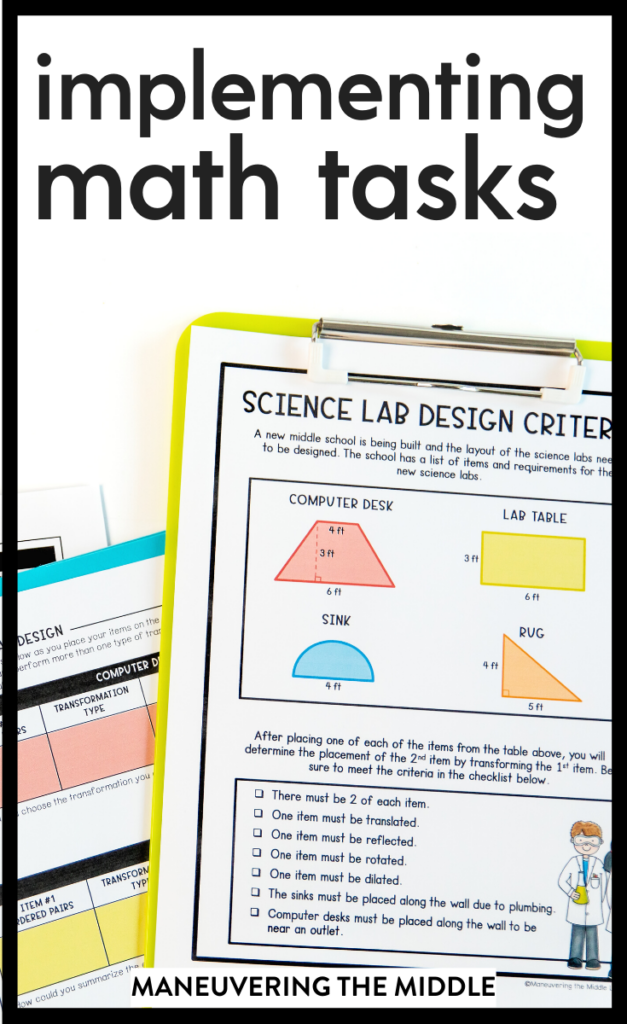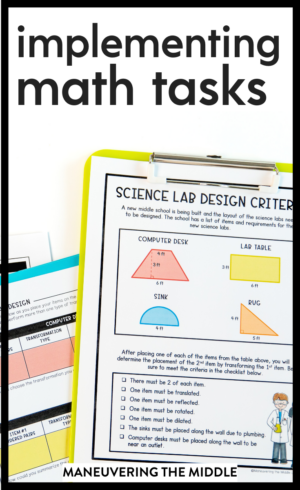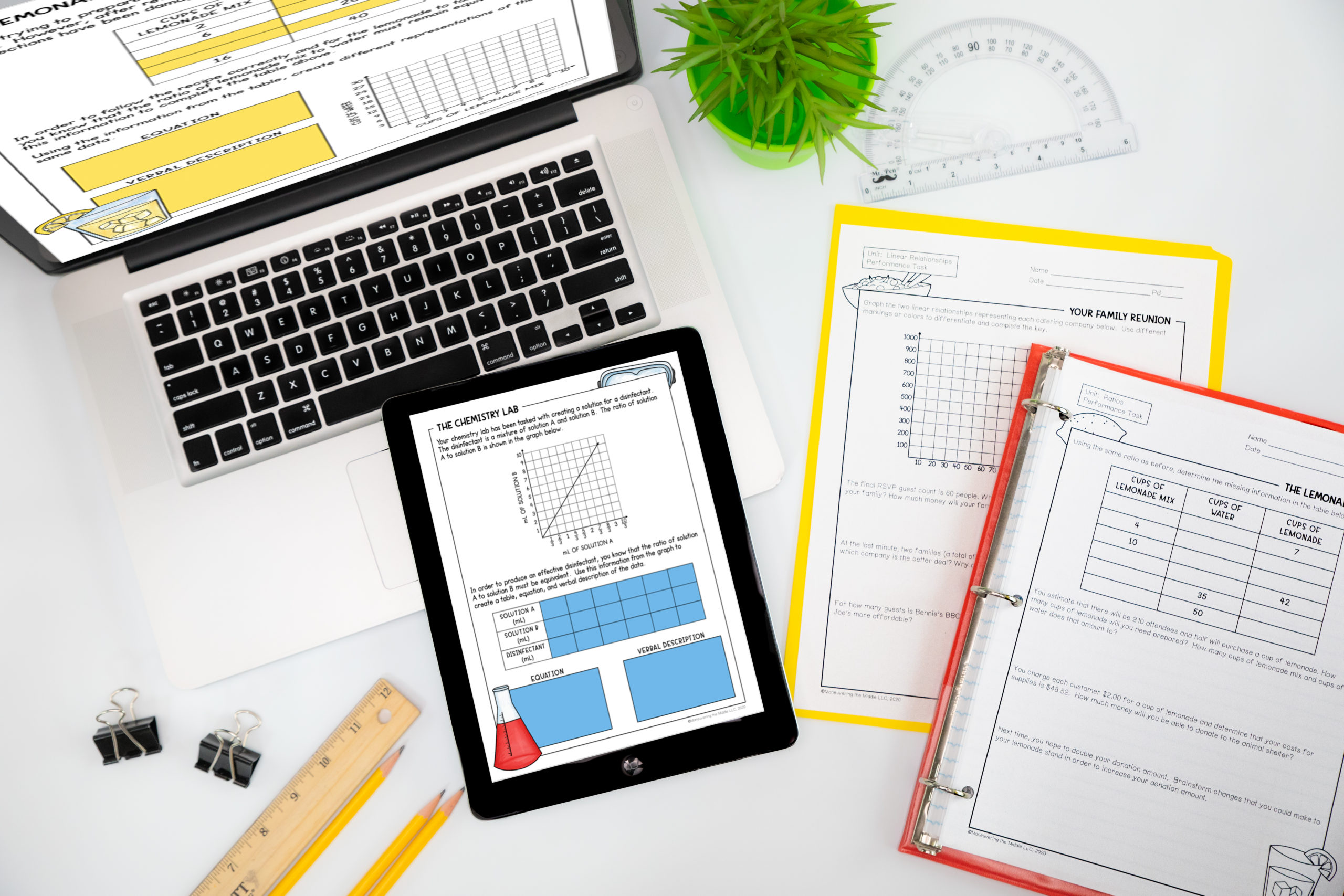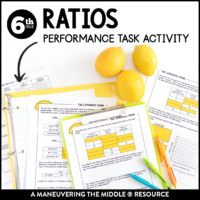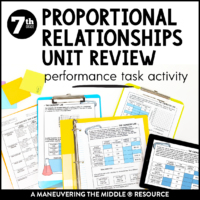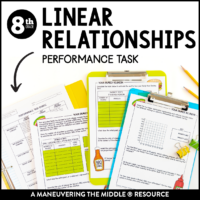The first performance task that I ever implemented was district provided and meant to replace the standard benchmark assessment. It did not go well; students felt defeated and I felt frustrated. Here is what I should have done:
Before I begin, let’s talk about what a performance task is:
“A performance task is any learning activity or assessment that asks students to perform to demonstrate their knowledge, understanding and proficiency. Performance tasks yield a tangible product and/or performance that serves as evidence of learning.” (From Defined Learning)
Keep reading to get a free performance task for middle school math + algebra 1.

1. Prepare Your Students
My first mistake was assuming that I could successfully replace a multiple-choice test with a performance task and act like they are the same. Performance tasks require students to not just recall what they have learned but apply what they have learned to a problem. The effort is more sustained. A student cannot circle an answer and move on to the next problem like they can on a traditional assessment.
If you plan to use a performance task as an assessment to be completed independently, I recommend you model and complete a performance task together with your class at some point during the unit. Consider it like a test review.
You will most likely receive higher quality work because students know what the criteria for success is. You can show how you want diagrams labeled, or how thorough their explanations need to be, or whatever your heart desires.
Performance tasks do not have to be an independent assignment or assessment! Our Maneuvering the Middle performance tasks are designed to be collaborative. Here are some ways you could assign performance tasks:
- Group Activity – Provide roles so all group members contribute.
- Partners – Assign partners. You can have a partner responsible for turning in one performance task that they both contributed to, or each student is still responsible for turning in their own task, but are still able to work collaboratively.
2. Provide Checkpoints and Opportunities for Feedback
A performance task typically encompasses everything learned in a unit, so the material is still very fresh to students. We want students to do well, right!? That is why I recommend checkpoints. Depending on the performance task, you may want to check students’ work before they proceed. You can do this a variety of ways:
- Draw a star on the performance tasks or circle a question number – when students reach this point, they raise their hand so you can check before they move on. (Bonus: this is also a great way to grade as you go! Instead of having a stack of paper to grade at the end, you can come up with a system on your clipboard that allows you to add or deduct points.)
- Circulate and keep circulating – You are probably already doing this, so keep on keeping on! I like to walk and add checkmarks to correct answers to give students confidence and prevent students from raising their hands to ask if the problem is correct. I want raised hands to be for questions, so I can prioritize appropriately.
- Check based on time elapsed – I also refer to this as chunking. Instead of telling students they have 50 minutes to complete the entire task, tell students they have 10 minutes for Section A, 15 minutes for Section B, and so on. Use these time restraints to circulate and check where students are and check for accuracy. “You should be wrapping up Section A. I am coming around to check while you work on Section B. You have 15 minutes to finish Section B.” *sets timer*

3. Complete the Performance Tasks Yourself Sans Answer Key
I recommend doing this for any assessment, assignment, or activity! Complete the performance tasks on your own without any assistance from a calculator (if students don’t get one) or without the answer key to guide you.
This will do 3 important things:
- This should give you an estimate for how long it will take a student to complete it. It is safe to assume that a student will take around 3 times longer to complete than the teacher. If this exceeds a class period, you can make plans to spend two class periods on the performance task or shorten the task to accommodate.
- Most importantly, it will help you identify areas where students may feel confused or need extra support. If you hesitate or have to reference something to proceed, your students most likely will too!
- If you created the performance task from scratch, consider asking another teacher to complete it to receive feedback. This might save you a headache later.
4. Students Who Need Motivation
Performance tasks require sustained effort which can be a challenge for some students. You still want to hold these students accountable for their work, but you can do a variety of tricks to keep them motivated. Students are generally motivated by choice and by learning about things that they care about. Can you alter the performance task to be about something that they love? Even if that means you take a pen and mark up their task on the fly.
Is the task accessible to them? If not, find an entry point. Perhaps, they need a formula or a filled-in-example . You may have to alter the task a bit for this to happen, but students have different needs and that is ok.
Last but not least, pulling a small group is a great place for students to feel supported and successful. You don’t have to do the task for them, but you can prompt them and keep a closer eye on them.

5. When to Implement a Performance Task
I love how Marissa implements a performance task! She assigns performance tasks the day after a test to her students who mastered their unit test. Performance tasks act as a perfect extension for these students who are ready to move on. For the students who did not master concepts from the unit test and need reteaching, she pulls a small group.
Maneuvering the Middle’s performance tasks are low-prep and also come in Google Slides format.
What tips do you have for implementing performance tasks?
